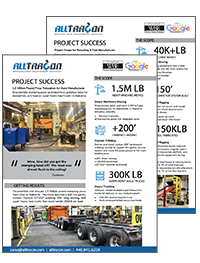Securing Heavy Machinery for Transport: A Comprehensive Guide by Alltracon
Transporting heavy machinery is a complex task that demands precision, expertise, and unwavering commitment to safety. At Alltracon, we understand the importance of securely moving heavy equipment, and in this blog, we’ll delve into the essential steps and considerations for securing heavy machinery for transport.
Assessment and Planning:
Before embarking on the journey, a thorough assessment is crucial. This includes evaluating the dimensions, weight, and fragility of the machinery. Plan the route, considering factors such as road conditions, bridges, and clearance heights. Ensure all necessary permits and paperwork are in order.
Equipment Inspection:
Inspect the machinery to ensure it’s in optimal working condition. Any loose parts, leaks, or potential hazards should be addressed. Remove any detachable components and secure them separately.
Expertise Matters:
Transporting heavy machinery is not a DIY job. Rely on professionals with experience in heavy haulage. At Alltracon, our team of experts knows the intricacies of securing and transporting heavy loads.
Customized Rigging and Bracing:
Each piece of machinery requires a customized approach to rigging and bracing. Use appropriate equipment like chains, straps, and blocking to secure the load. Pay close attention to weight distribution to prevent imbalance during transport.
Specialized Trailers and Trucks:
Select the right transport equipment for the job. Specialized trailers with ramps, lowboys, or flatbeds are often necessary. Ensure the trailer is well-maintained and up to the task.
Safety Precautions:
Safety should always be the top priority. Use warning signs, flags, and lights to make the load visible to other drivers. Secure all loose items on the machinery to prevent accidents. Additionally, follow all local and national safety regulations.
Communication and Escort:
Maintain clear communication with the driver and escort vehicles if needed. Radio communication is essential to ensure everyone is aware of the machinery’s movements and any potential obstacles on the road.
Regular Inspections:
Periodically inspect the load and its securing mechanisms during transit stops. This helps identify and rectify any issues before they become major problems.
Arrival and Unloading:
Upon reaching the destination, proceed with caution. Unload the machinery slowly and under controlled conditions. Ensure a clear path and a designated area for unloading.
Post-Transport Evaluation:
After the machinery is safely delivered, conduct a post-transport evaluation. Check for any damage or issues that may have arisen during transit. Document any findings for future reference.
Conclusion:
Securing heavy machinery for transport is a complex task that requires meticulous planning, specialized equipment, and experienced professionals. At Alltracon, we take pride in our commitment to the safe and reliable transport of heavy machinery. When you choose us, you’re choosing peace of mind and a partner dedicated to the successful delivery of your valuable assets. Contact Alltracon today for all your heavy machinery transport needs. Your machinery’s safety is our priority.


